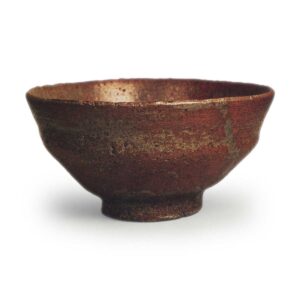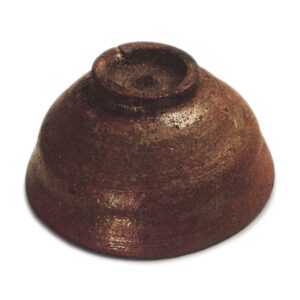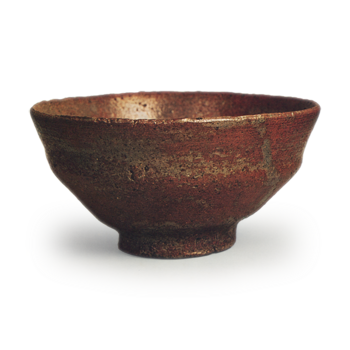

Collection: Fujita Museum of Art
Height: 6.5 – 7.3 cm
Diameter: 13.7 cm
Foot diameter: 5.9 cm
Height: 0.8 cm
The name Otsu was given in reference to the fact that it was owned by the Yanishi family of Otsu in Konan, and it is said to be one of the best bowls of the Kakinoobi type of wabi-mono, along with Iraho, and is called “Kyuhonichi” (Ryouun Honya’s “Kushinroku”).
The Kakinobori is also considered to be a type of formal tea bowl in terms of its shape, and it is a strong example of the Gohonte style, with the tea master’s preferences being reflected in the detailed aspects of the bowl, such as the clay, shape, texture and cutting. The tea book also says of the clay, “The clay of the Kakinobori is reddish-black and looks like a Japanese sparrowhawk, like the root of an irabo tree”. There are many common features in the simple, rustic styles of irabo, hina obi, and totoya (old name for zarameki), but first of all, the base material is a thin clay with a high iron content, thought to be produced in the area around Busan, and there are special techniques for cutting and drawing fine lines (hikime), and the roughness of the skin is also like what the tea master would like, so it is thought that all of these are based on the various conventions that have come out of the tea master’s cutting style. and fine lines (hikime) are made in a special way, and the roughness of the skin is also made to suit the taste of the user, and it is thought that all of these were made in accordance with the various rules that were followed by tea masters when cutting the shape of the pottery.
It is thought that the persimmon-shaped obi was also probably made in the early Edo period, in the early days of the Mamehara-no-Wakamono, in a kiln near Busan, in the same way as the Iroha, but the skill of the artisans in that area technique is able to handle the various conventions and conventions well, and it is great that it does not feel at all formal and bothersome, and it is great that it makes the best use of the unique flavor of the Goryeo tea bowl. This is why there is such a vast difference in quality between the tea bowls of the late Busan kiln and the tea bowls of the early period. The secret to why the early period tea bowls, which were somewhat different in style to the Ido and Kumagawa styles, were also considered to be Goryeo tea bowls, is thought to lie in this.
As mentioned above, the name “kakinobori” is derived from the similarity in shape and color, and in his “Kushinroku” (Record of Painstaking Effort), Hon’ya Ryoun also says that “shape is the most important thing” and gives the clear highlights of kakinobori, such as “the shape is good with a slight bulge” and “the shape is good with a slight bulge”. Other features of the Kaki-no-obi are said to include the kirimawashi, hikidai, vidro-yui and hosuji.
In the “Kushinroku” book, Otsu is praised as “the best in Japan, with a wonderful shape, a well-balanced shoulder and waist, and a slightly sloping waist.
The clay is fine and delicate, with countless fine lines running through it both inside and out, and the skin is very rough. While the water-based glaze is applied very thinly over the entire surface, it is unevenly distributed in places, creating a surprising pattern across the front. The rim is sharp and turned up, and the mouth is slightly cupped, creating a natural-looking mountain path. The interior is wide, and the tea pool stands neatly in the center, with about six eye marks lined up around it. The foot ring is made of clay, but the glaze is thin and worn, making it look like clay at first glance, and it is thin on one side, with a concave shape, and the inside is rounded off with a distinctive sharpness, with the helmet peak standing up sharply. There are two cracks in the mountain.
The greatest appeal of Otsu is in its shape, which gives a strong accent to the austere texture, and is very effective. In the case of plain objects, it is important to make the points stand out. In this respect, Otsu is a superb work, and Ryoun praised it as the best in Japan.
Accessories
Inner box: paulownia wood, plain, with paper pasted on it saying “Kaki no Ota”
outer box: Shunkei with beveled edges
overall box: black lacquer with lock and key, with inscription by Nagata Shingetsu “Kakinobu Otsu
(It is said that it was originally owned by the Otsu Yanishi family, and later passed through the Kurita and Kaga Kaizuka families before becoming part of the Fujita family collection, and is now in the collection of the Fujita Art Museum.



